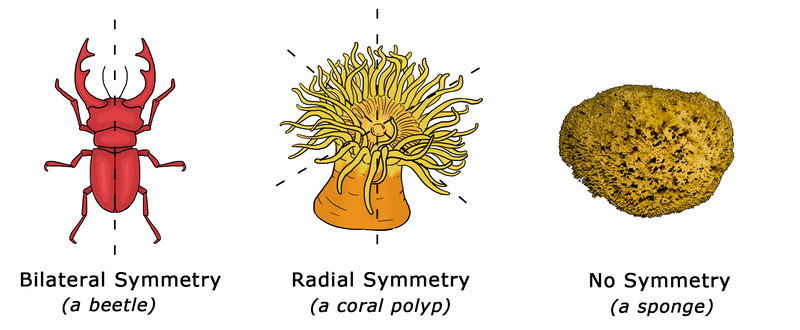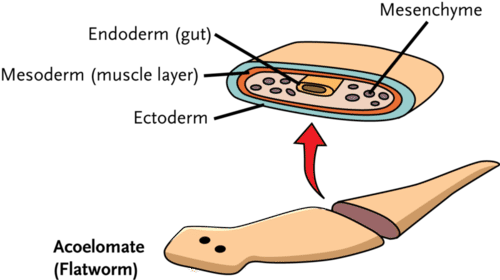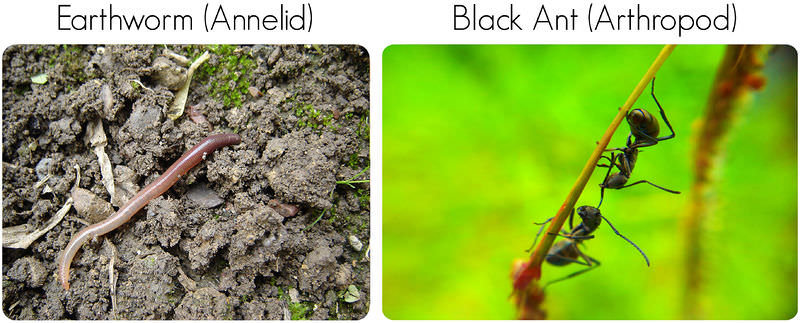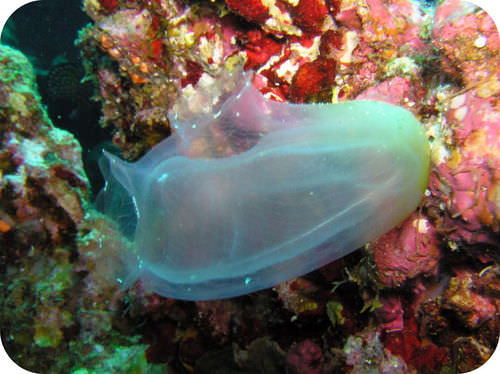11.2 无脊椎动物的演变
章节大纲
-
How many different types of beetles are there?
::有多少种不同的甲虫?There are about 350,000 of beetles spread all over the world. But let's focus on this one. Look at the detail on this Rhinoceros beetle. The horns are used in fighting other males during mating season, and for digging. The body of an adult rhino beetle is covered by a thick exoskeleton . A pair of thick wings lay atop another set of wings underneath, allowing the rhinoceros beetle to fly. Compare those evolutionary adaptations to a simple sponge, and the evolutionary significance of invertebrates becomes obvious.
::世界上散布着大约35万只甲虫。 但是让我们关注这个。 看看这个犀牛甲虫的详情。 角被用于在交配季节与其他雄鸟作战, 并用于挖掘。 成年犀牛甲虫的身体被厚厚的外骨骼覆盖。 一对厚的翅膀在下面的另一组翅膀上躺着, 允许犀牛甲虫飞翔。 把这些进化适应与简单的海绵相比, 无脊椎动物的进化意义变得显而易见。Invertebrate Evolution
::无脊椎进化Invertebrates evolved several important traits before vertebrates even appeared. These traits are now found in just about all .
::在脊椎动物出现之前,无脊椎动物就进化了几个重要特征。这些特征现在几乎全部都发现了。Multicellularity
::多细胞The first animal trait to evolve was multicellularity . This was highly adaptive. Multiple could do different jobs. They could evolve special adaptations that allowed them to do their job really well. However, the first invertebrates still lacked tissues . represent the first organism at the multicellular stage of invertebrate evolution.
::第一个进化的动物特征是多细胞特性。这是高度适应性的。 多重性可以做不同的工作。 它们可以演化特殊适应性, 从而真正让它们做好自己的工作。 但是, 第一批无脊椎动物仍然缺乏组织。 它代表着无脊椎进化多细胞阶段的第一个生物体。Tissues
::组织组织Living , such as jellyfish, represent the next stage of invertebrate evolution. This was the evolution of tissues. It was the first step in the evolution of organs and organ systems . At first, invertebrates developed tissues from just two embryonic cell layers. There was an outer cell layer called ectoderm and an inner cell layer called endoderm . The two cell layers allowed different types of tissues to form.
::生命,如水母,代表无脊椎动物进化的下一个阶段。这是组织进化过程。这是器官和器官系统进化的第一步。起初,无脊椎动物只从两个胚胎细胞层中培养了组织。有一个外细胞层叫做埃克托德姆,一个内细胞层叫做内脏。两个细胞层允许形成不同类型的组织。Radial Symmetry
::辐射对称Another trait that evolved early on was symmetry . To understand symmetry, you need to see an animal that lacks symmetry. A sponge, like the one in Figure , lacks symmetry. This means it cannot be divided into two identical halves. A symmetrical organism, in contrast, can be divided into two identical halves. Both the coral polyp and the beetle in Figure have symmetry.
::早期演变的另一个特征是对称性。 要理解对称性, 您需要看到一种缺乏对称性的动物。 海绵和图中的海绵一样, 缺乏对称性。 这意味着它不能被分成两半。 相反, 对称性有机体可以分为两半。 珊瑚聚虫和图中的甲虫都有对称性。Symmetry in Invertebrates. Sponges lack symmetry. Radial symmetry evolved first. This was followed by bilateral symmetry. How do the two types of symmetry differ?
::无脊椎动物的对称性。海绵缺乏对称性。对称性首先演变为对称性。随后是双边对称性。两种对称性如何区别?The coral polyp in Figure has radial symmetry . This was the first type of symmetry to evolve. The coral has a distinct top and bottom but not distinct ends. It can be divided into identical halves like a pie, but not into right and left halves. Animals with radial symmetry have no sense of directions such as forward and backward or left and right. This makes controlled movement in these directions impossible.
::图中的珊瑚聚点具有半径对称性。 这是第一种进化的对称性。 珊瑚的顶部和底部不同, 但目的不同。 它可以像派一样被一分为二, 但不能分为左右两半。 有半径对称性的动物没有前向、 后向或左右方向的感知。 这使得无法在这些方向有控制地移动 。Cephalization
::切喉化represent the next stage of invertebrate evolution. They evolved cephalization . This is the concentration of nerve tissue at one end of the body, forming a head region. This is highly adaptive. It allows central control of the entire organism. Cephalization was first step in the evolution of a brain .
::代表无脊椎进化的下一个阶段。 它们进化了通气化。 这是神经组织在身体一端的浓度, 形成一个顶部区域。 这是高度的适应性。 它允许整个有机体的中央控制。 通气化是大脑进化的第一步 。Bilateral Symmetry
::双边对称An outcome of cephalization was bilateral symmetry . This is demonstrated by the beetle in Figure . With concentrated nerve tissue at the head but not at the tail end, the two ends of the body are distinct from each other. The animal can be divided down the middle to form identical right and left halves. It allows the animal to tell front from back and left from right. This is needed for controlled movements in these directions.
::通气化的结果是双边对称。图中的甲虫证明了这一点。由于神经组织集中在头部,而不是尾端,身体的两端是不同的。动物可以从中间分裂成相同的右半部分。它允许动物从背部和左半部分。这些方向的受控运动需要这样做。Mesoderm
::中 度 代 数Ancestors of flatworms also evolved mesoderm . This is a third layer of cells between the ectoderm and the endoderm (see Figure ). Evolution of this new cell layer allowed animals to develop new types of tissues, such as muscle.
::扁虫的祖先也演变成中子代。这是在乳腺和内代尔姆之间细胞的第三层(见图 )。这一新细胞层的演变使动物得以发展新型的组织,如肌肉。Three Cell Layers in a Flatworm. A flatworm has three cell layers.
::3个细胞层在一条平虫中,1个扁虫有3个细胞层。Complete Digestive System
::完整的消化系统Early invertebrates had an incomplete digestive system . There was just one opening for the mouth and anus. Ancestors of modern were the first animals to evolve a complete digestive system . With a separate mouth and anus, food could move through the body in just one direction. This made digestion more efficient. An animal could keep eating while digesting food and getting rid of waste. Different parts of the digestive tract could also become specialized for different digestive functions. This led to the evolution of digestive organs.
::早期无脊椎动物有一个不完整的消化系统,只有一张嘴和肛门的开口。现代的祖先是最早形成一个完整的消化系统的动物。如果有一个单独的嘴和肛门,食物可以沿着一个方向穿过身体。这提高了消化效率。动物可以在消化食物和清除废物的同时继续进食。消化道的不同部分也可以专门用于不同的消化功能。这导致了消化器官的进化。Pseudocoelom and Coelom
::普塞多科洛姆和科埃洛姆Ancestors of roundworms also evolved a pseudocoelom . This is a partial body cavity that is filled with fluid. It allows room for internal organs to develop. The fluid also cushions the internal organs. The pressure of the fluid within the cavity provides stiffness. It gives the body internal support, forming a hydrostatic skeleton . It explains why roundworms are round and flatworms are flat. Later, a true coelom evolved. This is a fluid-filled body cavity, completely enclosed by mesoderm. It lies between the digestive cavity and body wall (see Figure ). Invertebrates with a true coelom include and .
::圆虫的祖先也进化出一个假阴极。 这是一个部分体腔, 里面装满液体。 它允许内部器官发展空间。 流体也让内部器官缓冲。 洞内液体的压力提供了硬性。 它为身体提供了内部支持, 形成一个静水的骨骼。 它解释了为什么圆虫是圆的, 扁虫是平的。 后来, 一个真正的圆柱子进化了。 这是一个装满液体的体腔, 完全由中间体组成。 它位于消化腔和身体墙之间( 见图 )。 具有真正内脏的脊椎包含并且包含 。Cross Section of an Invertebrate with a Coelom. The coelom forms within the mesoderm.
::脊椎骨和科伊洛姆的十字架 骨髓在中位数内形成Segmented Body
::分部分机构Segmentation evolved next. This is a division of the body into multiple segments. Both the earthworm and ant pictured in Figure have segmented bodies. This trait increases flexibility. It permits a wider range of motion. All annelids and are segmented. Arthropods also evolved jointed appendages . For example, they evolved jointed legs for walking and “feelers” (antennae) for sensing.
::接下来是分解。 这是将身体分成多个部分。 图中描绘的蚯蚓和蚂蚁都有分解体。 这个特性增加了灵活性。 它允许更广泛的运动范围。 所有内分泌并进行分解。 亚特罗福德还进化了连接的附属体。 例如, 它们为行走和感知“ 感官” 演化了连接的腿和“ 感官” ( antenade) 。Segmented Invertebrates. Earthworm (Annelid) and Black Ant (Arthropod). An earthworm consists of many small segments. An ant has three larger segments. Notice the ants jointed legs and “feelers.”
::脊椎动物、 蚯蚓( Annelid) 和 黑蚁( Arthropod) 。 蚯蚓由许多小部分组成。 蚂蚁有三个较大的部分。 注意蚂蚁的双腿和“ 感官 ” 。Notochord
::诺科Some invertebrates evolved a notochord . This is the stiff support rod in a . The first chordates were probably similar to modern . The sea squirt in Figure is an example. Later, some invertebrate chordates evolved into vertebrates.
::一些无脊椎动物进化成一个诺阿科多尔。这是在 a. 中的坚硬支撑杆。 最初的染色体可能与现代相似。 图中的海水喷发就是一个例子。 后来,一些无脊椎动物的染色体演变成脊椎动物。Notochord. A sea squirt is an invertebrate with a notochord.
::水喷泉是无脊椎动物,有无脊椎动物。Summary
::摘要-
Many important traits evolved in invertebrates. They include: multicellularity, tissues and organs, radial and bilateral symmetry, cephalization, mesoderm, complete digestive system, coelom, segmented body, and notochord.
::在无脊椎动物中,许多重要特征都演变为无脊椎动物,包括:多细胞、组织和器官、辐射和双边对称、气相化、中子成像、完整的消化系统、结叶、分块体和未切片。
Review
::回顾-
Distinguish among asymmetry, radial symmetry, and bilateral symmetry.
::区分不对称、辐射对称和双边对称。 -
Define cephalization. What is its relationship to bilateral symmetry?
::它与双边对称性有什么关系? -
What is mesoderm? Name an invertebrate with mesoderm.
::什么是中位数?用中位数命名无脊椎动物。 -
Define coelom. What invertebrates have a true coelom?
::定义科洛姆。什么无脊椎动物有真正的科洛姆? -
What is segmentation? Why is it advantageous?
::什么是分割,为什么有利? -
Compare and contrast incomplete and complete digestive systems. Why is a complete digestive system more efficient?
::比较和对比不完整和完整的消化系统。 为什么一个完整的消化系统更有效率?
-
Many important traits evolved in invertebrates. They include: multicellularity, tissues and organs, radial and bilateral symmetry, cephalization, mesoderm, complete digestive system, coelom, segmented body, and notochord.





